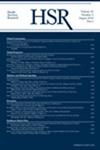Travel distance and outcomes after surgical aortic valve among veterans
Abstract
Objective
To investigate the association between travel distance and postoperative length of stay (LOS) and discharge disposition among veterans undergoing surgical aortic valve replacement (SAVR).
Data Sources/Study Setting
We performed a retrospective cohort study of patients undergoing SAVR, with or without coronary artery bypass grafting (CABG) at VA Boston Healthcare (January 1, 2005–December 31, 2015).
Study Design
Postoperative LOS and discharge disposition were compared for SAVR patients based on travel distance to the facility: <100 miles or ≥100 miles. Multivariable regression was performed to ascertain factors associated with LOS and home discharge.
Data Collection/Extraction Methods
Data were collected via chart review. All patients undergoing SAVR at our institution who primarily resided within the defined region were included.
Principal Findings
Of 597 patients studied, 327 patients underwent isolated SAVR; 270 patients underwent SAVR/CABG. Overall median (IQR) distance between the patient's residence and the hospital was 49.95 miles (27.41–129.94 miles); 190 patients (32%) resided further than 100 miles away. There were no differences in the proportion of patients with diabetes, hypertension, chronic obstructive pulmonary disease (COPD), cerebrovascular disease, atrial fibrillation, or prior myocardial infarction between groups. Overall LOS (IQR) was 9 (7–13) days and did not differ between groups (p = 0.18). The proportion of patients discharged home was higher among patients who resided more than 100 miles from the hospital (71% vs. 58%, p = 0.01). On multivariable analysis, residing further than 100 miles from the hospital was independently associated with home discharge (OR = 1.64, 95% CI: 1.09–2.48). Travel distance was not associated with LOS.
Conclusions
Based on our institutional experience, potential concerns of longer hospital stay or discharge to other inpatient facilities for geographically distanced patients undergoing SAVR do not appear supported. Continued examination of the drivers underlying the marked shift of veterans to the private sector appears warranted.

 求助内容:
求助内容: 应助结果提醒方式:
应助结果提醒方式:


